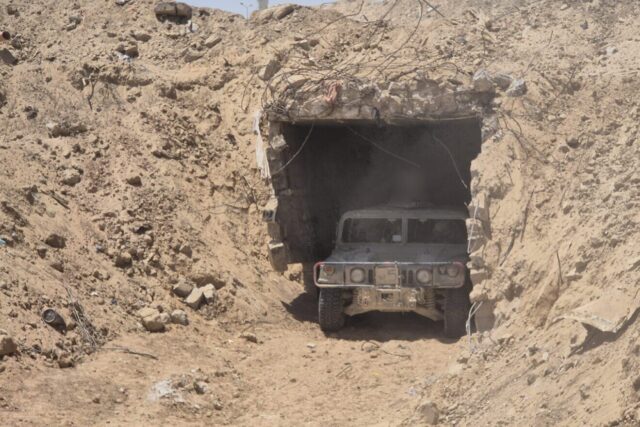
Not long ago, I wrote an article titled, “Hostage Talks Won’t Work; Winning the War Will.” A retired American military officer wrote to ask, “What is the definition of winning? What does winning look like?” He wasn’t questioning Israel’s capability; he added, “I am quite sure the IDF can deliver whatever is directed or defined.”
To be clear, an American military officer knows what winning looks like; he was checking on me. That made me nervous, but I also realized that people are projecting different end games on Israel. The Biden-Harris administration, for example, is pushing for a ceasefire and “de-escalation.” (President Joe Biden told Israel in mid-April to “pocket the win” after Iran fired 170 drones, 30 cruise missiles and more than 120 ballistic missiles at Israel and succeeded in killing only one person. Odd definition of a win.)
So, I took a shot.
“Winning” is achieving your war objectives. Israel had three clear objectives announced in October.
Secure the border and the people of Israel.
Previous ground and rocket attacks by Hamas and Hezbollah resulted in “ceasefires” that left the timing and scope of the next attack up to Israel’s enemies. There was a ceasefire in place on Oct. 6, and Hamas broke it in the most horrific manner on 10/7. The Israeli government said, “We don’t want another ceasefire, or a better ceasefire, or a longer ceasefire.”
The goal is to secure the border.
The United States settled for a ceasefire in Korea. And when the minuses outweighed the plusses in Vietnam, Iraq and Afghanistan, we went home. We put 6,000 or 10,000 miles between us and them. We ignored the mess, the refugees, the killings we left in our wake. For Israel, there is no going home; Israelis are home. If a secure border means a buffer along the Negev and Israeli forces in the Philadelphi Corridor, so be it.
Take away Hamas’s military and governing capabilities.
It doesn’t mean “kill them all” or “get a formal surrender.” It means removing the weapons and tunnels already inside Gaza, along with securing the borders so Hamas can’t import more. The tunnels at Rafah tell you that Egypt was a smuggling partner of Hamas. Israel, perhaps naively, assumed Egypt would live up to the agreements it signed in 1982 when Israel withdrew from Sinai and 2005 when Israel withdrew from Gaza. But no, so now Israel has to be in control.
Without military power, Hamas’s governing power wanes. If you believe, as some people do, that the Palestinians aren’t all Hamas themselves or that they don’t support Hamas, but they know Hamas will kill them if they rebel (Hamas has killed many Palestinian civilians since Israel’s invasion, including people trying to get to the “safe zones”), then you have to want the Hamas boot off their necks. The only way to do that for them is by removing the weapons Hamas uses to enforce its will, i.e., to kill them. Or, if you believe, as some people do, that Palestinian civilians do, in fact, support the genocidal program of Hamas, then Israel has to remove as much of the weaponry as possible from that space.
What comes next in governance is unclear. “Winning the peace,” wrote the general, is difficult.
He is right. We occupied Germany and Japan for years; we wrote their constitution and their textbooks, we told them what they could and couldn’t do, we told them who could and who couldn’t run for office and teach school. We outlawed Naziism, that’s a bit phony because, like the Muslim Brotherhood, outlawing doesn’t make it go away. But we succeeded in making it impolitic, impolite, costly, painful, and societally unacceptable to be an overt Nazi or perform Nazi acts.
The United Arab Emirates, Bahrain, Saudi Arabia and other Arab countries have had the experience of working to marginalize and kill the Muslim Brotherhood ideology. Sometimes, it works. That’s why the Abraham Accords countries, plus Saudi Arabia, have not broken the agreement and have not stopped talking to Israel. They get it.
Release the hostages.
This is tricky. It might have been possible to get a “deal” for about 145 Israeli hostages at a cost of about 2,000 Palestinian security prisoners in Israeli jails. Maybe.
But a trade has a massive downside. Trading security prisoners for civilians ensures that more hostages will be taken in the future.
Israel traded 1,000 Palestinian prisoners for an Israeli captive named Gilad Shalit. People were happy for a while, but among those released prisoners was Yahya Sinwar (today running around in women’s clothing to avoid capture, it seems) and a woman named Ahlam Tamimi, the mastermind of the 2001 Sbarro pizza bombing in Jerusalem that killed 16 civilians. Tamimi now lives protected in Jordan, though U.S. and Jewish leaders have pushed to seek her extradition.
Many other released prisoners have returned to terrorism, including some released in the first hostage trade from this war.
On the first two goals, Israel is clearly winning. On the third, the answer is more mixed, but perhaps the rescue of hostage Qaid Farhan Alkadi, the Bedouin Muslim Israeli father of 11, is a harbinger of a positive outcome.
So, how did I do?

